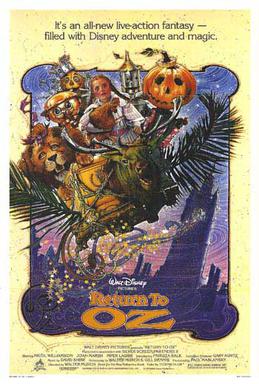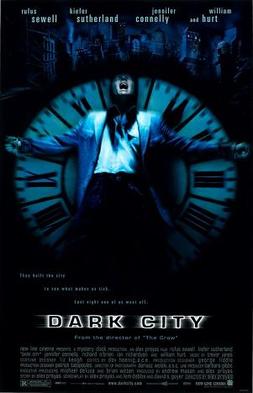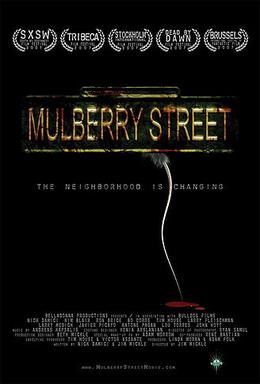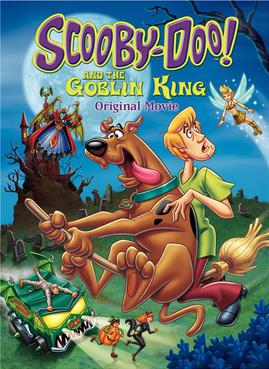
Blade Runner is a 1982 science fiction film, directed by Ridley Scott and written by Hampton Fancher and David Peoples. Starring Harrison Ford, Rutger Hauer, Sean Young, and Edward James Olmos, it is an adaptation of Philip K. Dick's 1968 novel Do Androids Dream of Electric Sheep? The film is set in a dystopian future Los Angeles of 2019, in which synthetic humans known as replicants are bio-engineered by the powerful Tyrell Corporation to work on space colonies. When a fugitive group of advanced replicants led by Roy Batty (Hauer) escapes back to Earth, burnt-out cop Rick Deckard (Ford) reluctantly agrees to hunt them down.

Sir Ridley Scott is an English filmmaker. He is best known for directing films in the science fiction, crime and historical drama genres. His work is known for its atmospheric and highly concentrated visual style. He ranks among the highest-grossing directors and has received many accolades, including the BAFTA Fellowship for lifetime achievement in 2018, two Primetime Emmy Awards, and a Golden Globe Award. He was knighted by Queen Elizabeth II in 2003 and appointed Knight Grand Cross of the Order of the British Empire by King Charles III in 2024.

Dawn of the Dead is a 1978 zombie horror film written, directed, and edited by George A. Romero, and produced by Richard P. Rubinstein. An American-Italian international co-production, it is the second film in Romero's series of zombie films, and though it contains no characters or settings from the preceding film Night of the Living Dead (1968), it shows the larger-scale effects of a zombie apocalypse on society. In the film, a phenomenon of unidentified origin has caused the reanimation of the dead, who prey on human flesh. David Emge, Ken Foree, Scott Reiniger, and Gaylen Ross star as survivors of the outbreak who barricade themselves inside a suburban shopping mall amid mass hysteria.

Kingdom of Heaven is a 2005 epic historical drama film directed and produced by Ridley Scott and written by William Monahan. It features an ensemble cast including Orlando Bloom, Eva Green, Jeremy Irons, David Thewlis, Brendan Gleeson, Marton Csokas, Edward Norton, and Liam Neeson.

Return to Oz is a 1985 dark fantasy film released by Walt Disney Pictures, co-written and directed by Walter Murch. It stars Nicol Williamson, Jean Marsh, Piper Laurie, and Fairuza Balk as Dorothy Gale in her first screen role. The film is an unofficial sequel to the 1939 Metro-Goldwyn-Mayer film The Wizard of Oz, and it is based on L. Frank Baum's early 20th century Oz novels, mainly Ozma of Oz (1907). In the plot, an insomniac Dorothy returns to the Land of Oz to find it has been conquered by the wicked Nome King and his accomplice Princess Mombi. Dorothy must restore Oz with her new friends Billina, Tik-Tok, Jack Pumpkinhead, and the Gump.
Mia Sarapochiello, known professionally as Mia Sara, is an American actress. She made her film debut as Princess Lili in the fantasy film Legend (1985), and had her breakthrough role starring as Sloane Peterson in the comedy film Ferris Bueller's Day Off (1986). She also portrayed Melissa Walker in the science fiction film Timecop (1994), which won her the Saturn Award for Best Supporting Actress.

The Howling is a 1981 American horror film directed and edited by Joe Dante. Written by John Sayles and Terence H. Winkless, based on the novel of the same name by Gary Brandner, the film follows a news anchor who, following a traumatic encounter with a serial killer, visits a resort secretly inhabited by werewolves. The cast includes Dee Wallace, Patrick Macnee, Dennis Dugan, Christopher Stone, Belinda Balaski, Kevin McCarthy, John Carradine, Slim Pickens, and Elisabeth Brooks.

Dark City is a 1998 neo-noir science fiction film directed by Alex Proyas, and starring Rufus Sewell, William Hurt, Kiefer Sutherland, Jennifer Connelly, Richard O'Brien and Ian Richardson. The screenplay was written by Proyas, Lem Dobbs, and David S. Goyer. In the film, Sewell plays an amnesiac man who, finding himself suspected of murder, attempts to discover his true identity and clear his name while on the run from the police and a mysterious group known as the "Strangers".
"The Steadfast Tin Soldier" is a literary fairy tale by Hans Christian Andersen about a tin soldier's love for a paper ballerina. The tale was first published in Copenhagen by C.A. Reitzel on 2 October 1838 in the first booklet of Fairy Tales Told for Children. New Collection. The booklet consists of Andersen's "The Daisy" and "The Wild Swans". The tale was Andersen's first not based upon a folk tale or a literary model. "The Steadfast Tin Soldier" has been adapted to various media including ballet and animated film.
Robin R. Bottin is an American special make-up effects creator. Known for his collaborations with directors John Carpenter, Paul Verhoeven and David Fincher, Bottin worked with Carpenter on both The Fog and The Thing, with Verhoeven on RoboCop, Total Recall and Basic Instinct, and with Fincher on Se7en and Fight Club. His many other film credits include The Howling, Legend, Innerspace and Fear and Loathing in Las Vegas.

Planet of the Vampires is a 1965 science fiction horror film produced by Fulvio Lucisano, directed by Mario Bava, that stars Barry Sullivan and Norma Bengell. The screenplay, by Bava, Alberto Bevilacqua, Callisto Cosulich, Antonio Roman and Rafael J. Salvia, was based on an Italian-language science fiction short story, Renato Pestriniero's "One Night of 21 Hours". American International Pictures released the film as the supporting film on a double feature with Daniel Haller's Die, Monster, Die! (1965).
Jenny Greenteeth a.k.a. Wicked Jenny, Ginny Greenteeth and Grinteeth is a figure in English folklore. A river-hag, similar to Peg Powler and derived from the grindylow, she would pull children or the elderly into the water and drown them. The name is also used to describe pondweed or duckweed, which can form a continuous mat over the surface of a small body of water, making it misleading and potentially treacherous, especially to unwary children. With this meaning the name is common around Liverpool and southwest Lancashire.

Legend is the twenty-eighth major release and the eighth soundtrack album by the German band Tangerine Dream. It was released in 1986 for the North American theatrical version of the film Legend. It was released in the USA and Canada only. The film was written by William Hjortsberg, starred Tom Cruise, Mia Sara and Tim Curry, was produced by Arnon Milchan, directed by Ridley Scott and released domestically by Universal Studios. The album was released on compact disc on 15 August 1995 through Varese Sarabande.

Someone to Watch Over Me is a 1987 American neo-noir romantic thriller film directed by Ridley Scott and written by Howard Franklin. It stars Tom Berenger as a police detective who has to protect a wealthy woman, who is a key witness in a murder trial. The film's soundtrack includes the George and Ira Gershwin song from which the film takes its title, recorded by Sting, and Vangelis' "Memories of Green", originally from Scott's Blade Runner (1982).

Mulberry Street is a 2006 American horror film directed by Jim Mickle, written by Nick Damici and Jim Mickle, and starring Nick Damici. It was released by After Dark Films as a part of their 8 Films to Die For 2007.

Seven different versions of Ridley Scott's 1982 science fiction film Blade Runner have been shown, either to test audiences or theatrically. The best known versions are the Workprint, the US Theatrical Cut, the International Cut, the Director's Cut, and the Final Cut. These five versions are included in both the 2007 five-disc Ultimate Collectors Edition and 2012 30th-Anniversary Collector's Edition releases.

Scooby-Doo! and the Goblin King is a 2008 direct-to-DVD animated comedy horror musical film, and the twelfth in the series of Scooby-Doo direct-to-video films produced by Warner Bros. Animation. It was dedicated to Paulette Oates, who helped resurrect Warner Bros. Animation in the late 1980s. The DVD was released on September 23, 2008. This is the first Scooby cartoon produced entirely without either one of the original producers, William Hanna and Joseph Barbera.

Rumpelstiltskin is a 1995 American fantasy horror comedy film directed by Mark Jones and starring Max Grodénchik as the title character.

Black Cat Mansion is a 1958 Japanese supernatural horror film directed by Nobuo Nakagawa for Shintoho. The film is presented in a nonlinear narrative, taking place in the characters' present and past, and in the distant past. It is one of several Japanese "ghost cat" films, featuring a cat-like supernatural entity.

Alien is a 1979 science fiction horror film directed by Ridley Scott and written by Dan O'Bannon. Based on a story by O'Bannon and Ronald Shusett, it follows the crew of the commercial space tug Nostromo, who, after coming across a mysterious derelict spaceship on an uncharted planetoid, find themselves up against a deadly and aggressive extraterrestrial loose within their vessel. The film stars Tom Skerritt, Sigourney Weaver, Veronica Cartwright, Harry Dean Stanton, John Hurt, Ian Holm, and Yaphet Kotto. It was produced by Gordon Carroll, David Giler, and Walter Hill through their company Brandywine Productions and was distributed by 20th Century-Fox. Giler and Hill revised and made additions to the script; Shusett was the executive producer. The Alien and its accompanying artifacts were designed by the Swiss artist H. R. Giger, while concept artists Ron Cobb and Chris Foss designed the more human settings.



















